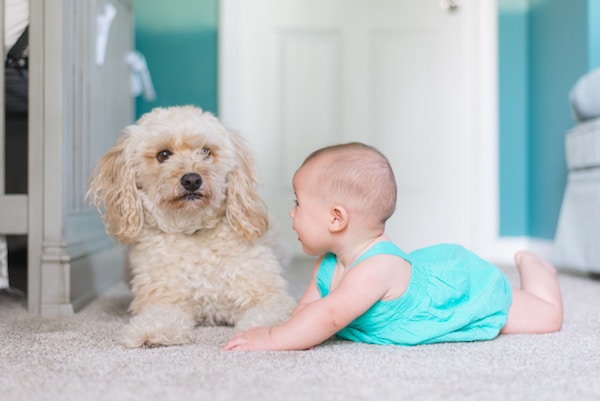Pets and kids can be a match made in heaven We’ve written before about how your child can really benefit from being around pets from an early age (read it here). But there’s no doubt that keeping the peace between your human babes and fur babes does require effort and preparation. There’s always some risk involved in pets and children co-existing, but there are some strategies you can put in place to ensure a happy and harmonious friendship between ALL family members.
Pet-tiquette for dogs you don’t know:
If a child encounters a strange dog they don’t know, they’re less likely to know how to behave. This is why it’s extra important to talk to your child about how to treat animals, even if you don’t have pets yourself. This helps them become more confident in gauging an unfamiliar dog or cat’s mood. Some things to consider include:
- teaching your child to be a ‘tree’. They should let a dog they’re meeting for the first time sniff them and know that running away may encourage a dog to chase her, misconstruing the action as a gesture of play.
- making sure they always approach unfamiliar dogs slowly and only if needed, such as well a dog will be in close proximity at a gathering or similar. Stray dogs should always be left alone entirely.
- let them know that sudden movements, yelling, hitting or staring directly into a dog’s eyes will almost always antagonise it. Help them spot warning signs, such as growling, upstanding fur or bared teeth.
Pet-tiquette for dogs you do know:
You could easily assume that unfamiliar dogs pose the greatest threat to children, particularly toddlers. But according to Victorian Health,
“Children five years old or younger are most at risk and are most frequently bitten by their own or a friend’s dog, usually in or around the home.” Most incidents of aggression are brought about when a child is engaging in ‘play’ with a dog, or confronting a dog when sleeping or eating. This means that it’s essential to teach your kids how to act around your pets, and supervise all interactions when smaller children are involved.
- Encourage your child to stroke a dog’s back and sides, rather than approaching them by reaching over their head. Wrestling and tug-of-war should be discouraged as this can be misconstrued by the dog and may result in a bite.
- Teach them to avoid upsetting a dog who is eating or sleeping.
- Ensure they avoid loud play around cats and have a dedicated space for your cat to retreat to, where a child will be instructed not to follow it. A child should always avoid bothering a hiding, sleeping or eating cat, or one that’s playing with it’s toys. Interrupting a cat involved in this kind of play will often result in aggression, as will picking one up.
- Use baby gates to separate your child and cat/dog when needed. Consider a crate which can provide a retreat for the animal in question. This is especially important if you have a small pet. While a larger dog might be able to handle some rough treatment from an over-active toddler, a light-weighing pup won’t be so resilient!
Preparing your pet to be around children:
While most animals will only resort to aggression if they are antagonised, you should still take every precaution. Starting with doggie obedience classes is a great idea (as early as 12 weeks). This will prevent your dog habitually jumping on others and ensure they respond to commands quickly. It’s also important to exercise your dog as regularly as possible. A tense and hyperactive pet is far more likely to lash out when provoked. Involving your children in exercising your pets can be a great thing to do, under careful supervision.
When it comes to felines, declawing is a possibility but should be treated as a last resort. However, this should be a last resort. Keeping your cat indoors will also reduce the risk of fleas and ticks. This can not only be dangerous for your pet, but for your child too.
Don’t let your child handle a cat’s litter box or scoop up doggie doo. This puts them at risk of certain parasite-spread diseases. Also ensure that your dogs are spayed or neutered at the appropriate age. Failure to get a dog ‘fixed’ often means they are more likely to be aggressive.

